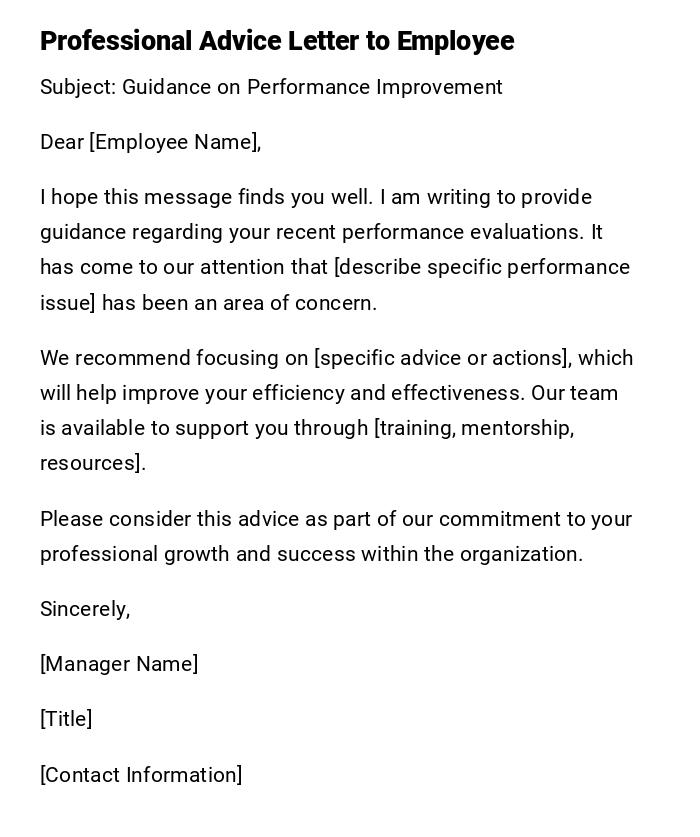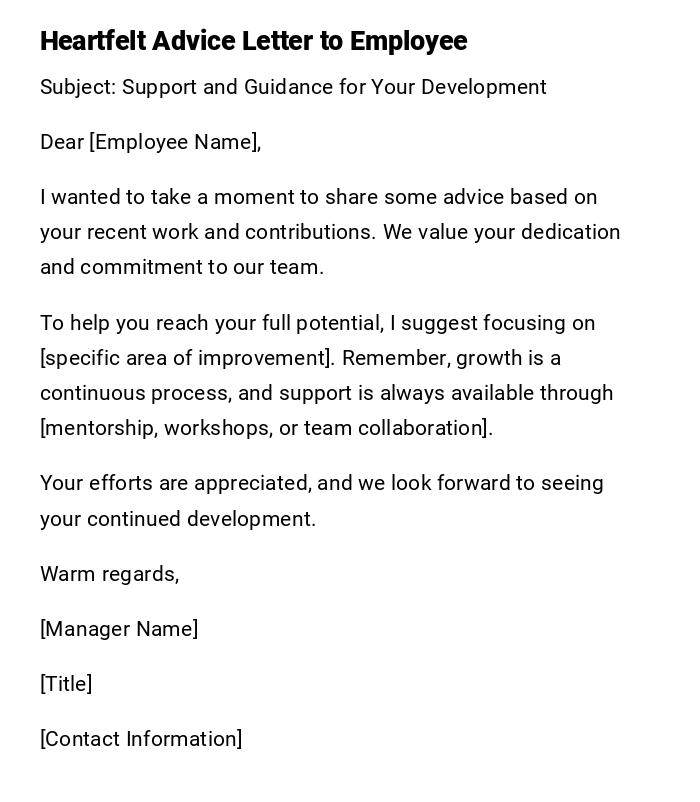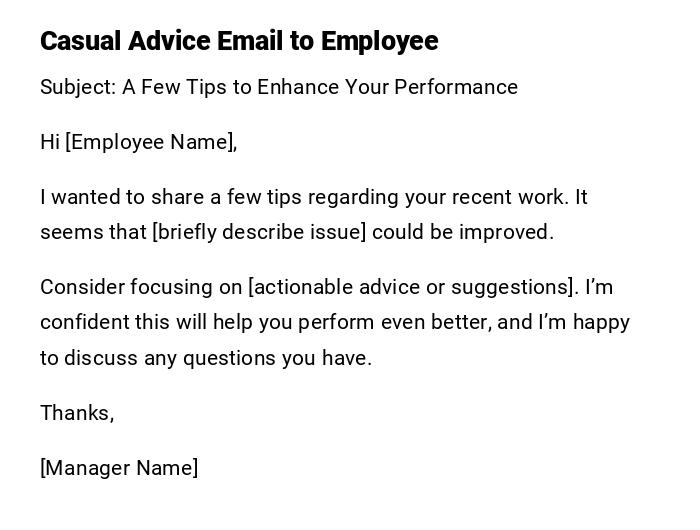Advice Letter To Employee
Dear [Employee's Name],
I hope this letter finds you well. I wanted to take this opportunity to express my gratitude and offer some words of advice and encouragement to you.
First and foremost, I want to acknowledge your dedication and hard work as an essential part of our team at [Company Name]. Your commitment to excellence and your contributions have been invaluable to the success of our company.
As you continue your journey with us, I would like to share some advice that I believe will not only help you excel in your current role but also grow personally and professionally:
1. Embrace Learning: The business landscape is constantly evolving, and staying up-to-date with the latest industry trends and technologies will give you a competitive edge. Take advantage of any training opportunities or workshops offered by the company to enhance your skills and knowledge.
2. Seek Feedback: Don't hesitate to ask for feedback from your colleagues, superiors, and subordinates. Constructive criticism can help you identify areas of improvement and foster personal growth.
3. Time Management: Strive to manage your time efficiently by setting clear priorities and deadlines. This will not only improve your productivity but also reduce stress and allow for a better work-life balance.
4. Foster Collaboration: Effective collaboration and teamwork are vital for achieving shared goals. Be open to sharing ideas and supporting your colleagues, as this will create a positive and productive work environment.
5. Stay Positive: Positivity and a can-do attitude are infectious and can inspire those around you. Embrace challenges with optimism and focus on finding solutions rather than dwelling on problems.
6. Take Care of Yourself: Remember to prioritize self-care and well-being. A healthy and rested mind and body are essential for maintaining high levels of performance and creativity.
7. Be Adaptable: Change is inevitable in any organization, and being adaptable will help you navigate through uncertainties and new opportunities with confidence.
Lastly, I want to emphasize that your growth and success matter to us. If you have any concerns, suggestions, or aspirations, feel free to discuss them with me or your immediate supervisor. We are here to support your professional development and provide a fulfilling work experience.
Once again, thank you for your commitment and dedication to [Company Name]. Your contributions are truly appreciated. I am confident that with your talent and determination, you will continue to achieve great things within our organization.
Wishing you continued success and fulfillment in your role.
Sincerely,
[Your Name]
[Your Title/Position]
[Company Name]
Professional Advice Letter to Employee
Subject: Guidance on Performance Improvement
Dear [Employee Name],
I hope this message finds you well. I am writing to provide guidance regarding your recent performance evaluations. It has come to our attention that [describe specific performance issue] has been an area of concern.
We recommend focusing on [specific advice or actions], which will help improve your efficiency and effectiveness. Our team is available to support you through [training, mentorship, resources].
Please consider this advice as part of our commitment to your professional growth and success within the organization.
Sincerely,
[Manager Name]
[Title]
[Contact Information]
Heartfelt Advice Letter to Employee
Subject: Support and Guidance for Your Development
Dear [Employee Name],
I wanted to take a moment to share some advice based on your recent work and contributions. We value your dedication and commitment to our team.
To help you reach your full potential, I suggest focusing on [specific area of improvement]. Remember, growth is a continuous process, and support is always available through [mentorship, workshops, or team collaboration].
Your efforts are appreciated, and we look forward to seeing your continued development.
Warm regards,
[Manager Name]
[Title]
[Contact Information]
Casual Advice Email to Employee
Subject: A Few Tips to Enhance Your Performance
Hi [Employee Name],
I wanted to share a few tips regarding your recent work. It seems that [briefly describe issue] could be improved.
Consider focusing on [actionable advice or suggestions]. I’m confident this will help you perform even better, and I’m happy to discuss any questions you have.
Thanks,
[Manager Name]
Formal Advisory Letter to Employee
Subject: Advisory on Professional Conduct
Dear [Employee Name],
Following recent observations of your work performance, we wish to provide formal advice to support your professional growth. Areas requiring attention include [specific issues].
We strongly advise implementing [specific corrective measures or strategies]. Compliance with these suggestions is essential for maintaining team standards and achieving performance objectives.
Sincerely,
[HR Manager Name]
[Title]
[Contact Information]
Preliminary Guidance Letter for Employee
Subject: Initial Recommendations for Improvement
Dear [Employee Name],
This letter is intended to provide preliminary advice regarding your current performance in [specific area]. We have identified [concern] as a key area for improvement.
You are encouraged to [suggested actions or training], which will support your growth and development within the company. Feedback sessions will be scheduled to monitor your progress.
Thank you for your attention to this matter.
Sincerely,
[Manager Name]
[Title]
Encouraging Advice Letter to Employee
Subject: Guidance for Continued Success
Dear [Employee Name],
I want to acknowledge your hard work and dedication. To further enhance your contributions, I suggest focusing on [specific skill or task].
Taking these steps will help you excel and gain confidence in your role. Remember, our team is here to support you every step of the way.
Best regards,
[Manager Name]
[Title]
[Contact Information]
What an Advice Letter to Employee Is and Why You Need It
- A written communication providing guidance, recommendations, or instructions to an employee.
- Purpose:
- Address performance, behavior, or professional development.
- Ensure clarity and formal documentation of advice.
- Support employee growth and organizational standards.
Who Should Send an Advice Letter to an Employee
- Immediate supervisors or managers.
- Human Resources personnel when formal guidance is needed.
- Senior leadership for organizational compliance or policy matters.
Whom the Advice Letter Should Be Addressed To
- Individual employee concerned.
- Copy to HR or department head when appropriate for record-keeping.
- Occasionally, team leads if collaborative guidance is necessary.
When to Send an Advice Letter to an Employee
- Following performance reviews or evaluations.
- After observed incidents of concern or behavior needing correction.
- When providing developmental guidance, training recommendations, or career advice.
How to Write and Send an Advice Letter
- Steps:
- Begin with a clear subject line specifying purpose.
- Use a respectful and professional salutation.
- Clearly outline the issue, concern, or area for improvement.
- Provide actionable advice or recommendations.
- Close with support and willingness to assist.
- Send via email for informal advice or as a printed letter for formal records.
Requirements and Prerequisites Before Sending
- Documented observations or performance data.
- Knowledge of company policies and procedures.
- Clear understanding of the employee’s role and responsibilities.
- Optional: supporting resources, such as training programs or mentorship plans.
Formatting Guidelines for Advice Letters to Employees
- Length: Typically one page; concise yet complete.
- Tone: Professional, respectful, and supportive.
- Style: Formal for official records, casual for informal guidance.
- Mode: Email for quick communication; letter for formal documentation.
- Include subject, salutation, body, and closing with signature.
After Sending an Advice Letter
- Confirm receipt with the employee, if appropriate.
- Schedule follow-up meetings to monitor progress.
- Keep a record for HR or performance documentation.
- Provide ongoing support and feedback to ensure implementation.
Pros and Cons of Sending an Advice Letter
- Pros:
- Provides clear, documented guidance.
- Supports employee development and organizational standards.
- Encourages accountability and professional growth.
- Cons:
- May be perceived negatively if tone is overly critical.
- Can require follow-up and monitoring for effectiveness.
Common Mistakes to Avoid in Advice Letters
- Being vague or unclear about the issue.
- Using a harsh or accusatory tone.
- Failing to provide actionable recommendations.
- Omitting follow-up instructions or support options.
Elements and Structure of an Advice Letter to Employee
- Subject line specifying purpose.
- Salutation addressing the employee.
- Introduction outlining reason for writing.
- Body describing observations and providing recommendations.
- Closing offering support and encouragement.
- Signature and contact information.
- Optional attachments: supporting documents or reference materials.
Tricks and Tips for Effective Advice Letters
- Focus on solutions, not just problems.
- Keep tone positive and constructive.
- Provide clear, actionable steps for improvement.
- Encourage open communication and follow-up.
- Maintain documentation for HR or performance records.
FAQ About Advice Letters to Employees
-
Q: Can advice letters be informal?
A: Yes, for minor guidance, an email may suffice; formal letters are preferred for official documentation. -
Q: Should all advice letters be documented?
A: Important or performance-related advice should be documented for accountability. -
Q: Is follow-up necessary?
A: Yes, to ensure recommendations are understood and acted upon. -
Q: Can advice letters be positive only?
A: Yes, they can provide guidance on development even when performance is good.
Does an Advice Letter Require Attestation or Authorization?
- Usually no formal attestation is required.
- Signed letters by the manager or HR are standard.
- In certain disciplinary contexts, HR authorization may be necessary.








 Download Word Doc
Download Word Doc
 Download PDF
Download PDF